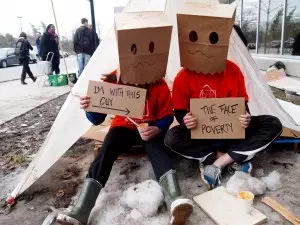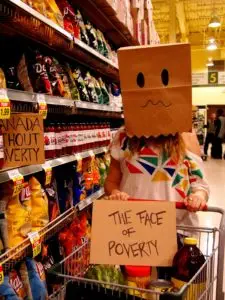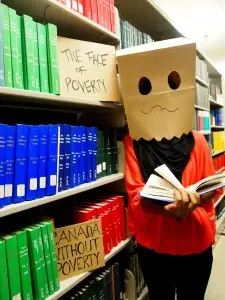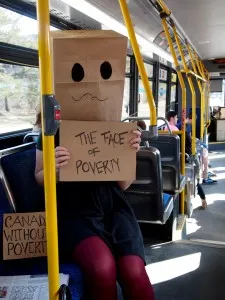*By CWP Intern Emily Shoff

Poverty is a complex issue. There is not one particular ‘type’ of person or population who experiences the struggles of low-income. During my internship at Canada Without Poverty, a central point I have come to understand is that while homelessness is one part of the entire picture, it remains the mainstream idea of who is poor. As part of Engage Ottawa, I wanted to confront the stereotypes of poverty with a photo project and offer provocative images that spark conversation. (Scroll down to see the photos)
The Face of Poverty attempts to capture the various identities of poverty. Homelessness is the most visible form of poverty but it is not the only face of poverty. Poverty in Canada involves the deprivation of resources, finances and the capacity to participate fully in society. The term ‘poverty’ is diverse and encapsulates the struggles of the working poor, the indebted university student, the new immigrant.
I wanted to raise awareness, dispel the myths of poverty, get members of the community to participate in the conversation and make them think. Educating civil society is part of Canada Without Poverty’s mission.
Why the bag? It further illustrates the point that these individuals are everyday citizens; there is no single face of poverty.
The original plan was to capture 10 photos illustrating different aspects of life for those struggling with poverty (single mothers, new immigrants, Aboriginal peoples, women), however people were resistant.
I realized that just because I am comfortable talking about poverty, dissecting its meaning and critically thinking about why it exists, doesn’t mean that someone who is not engrossed in the work is just as curious: I even tried pulling “it’s for a school project”! And so the list of 10 fell to 6.

Poverty is stigmatized. There is a lack of understanding about what poverty is and furthermore who lives in it. I visited several independent coffee shops to snap a photo to represent the working poor. People were resistant because they felt hypocritical. Yet they’re most likely making minimum wage and stretching their paycheques to make ends meet. Some may even have a diploma or degree indicating that they can work in a field other than customer service. In Ontario, minimum wage is $10.25/hour, which generates an annual income of $18,655. The poverty line rests at $19 719 creating an income gap of $1064.
We’re blinded by the symptoms of poverty. Take my own status for example – a full-time post-secondary student. It’s daunting to know that after graduation the average unemployment rate for youth (15-24) stands at 14% (double the national unemployment rate) which was 7.4% as of February 2012. Don’t forget the massive amount of debt post-graduation, or the reality that having a full-time job can still mean pressing every penny made because of low wages and inadequate benefits. A certificate does not mean a safe zone from poverty.
As you analyze these photos, challenge yourself to move beyond your current understanding of who lives in poverty, and start to consider the low-wage problem that causes many individuals and families to struggle daily.


- For people living in poverty, a car is a luxury. While the bus is a cheaper alternative for many, transit is not always affordable if you have limited income. In Ottawa, a monthly adult bus pass costs $94. A single person on welfare receives $654.50 a month to cover this expense as well rent, food and other living expenses.




